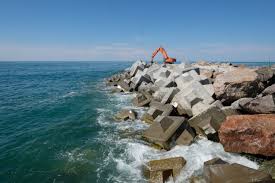LIMITS OF CURRENT TECHNOLOGIES
The most common solutions to reduce the wave motion consist of barriers in boulders. These determine the line where the waves break, tend to move the coastal currents offshore and create a discontinuity in the solid transport with a consequent reduction in the contribution of sediments from the protected beach to the neighbouring coasts. Frequently such constructions lead to a deterioration in the quality of the waters and the coastal seabed with an increase in the turbidity of the water. Furthermore, at the ends of the barriers, the seabed becomes deeper, creating dangers for bathing.

Barriers with boulders and concrete modules, Port of Hanstholm - Denmark
A variant of the previous solution are the cliffs or permeable barriers with unconventional artificial elements (prefabricated modules in concrete, steel, fiberglass, or made with 3D printers using for example local sands). These solutions maintain a fair water circulation, good oxygenation conditions and circulation of the interclosed waters and good characteristics of the seabed. These works therefore appear to have more limited impacts and greater eco-compatibility performance compared to traditional barriers. However, the visual impact of these structures remains very high, with non-negligible consequences for the attractiveness of tourist resorts.
Other types of non-traditional works aimed at dampening the wave action are the systems of floating barriers anchored to the bottom. These have the advantage of having a lower impact on the ecosystem than traditional massive structures and have the advantage of being easily removed. However, floating devices have a strong visual impact.

Floating breakwater to protect lake docks, Degray Lake State Park - Arkansas (USA)





